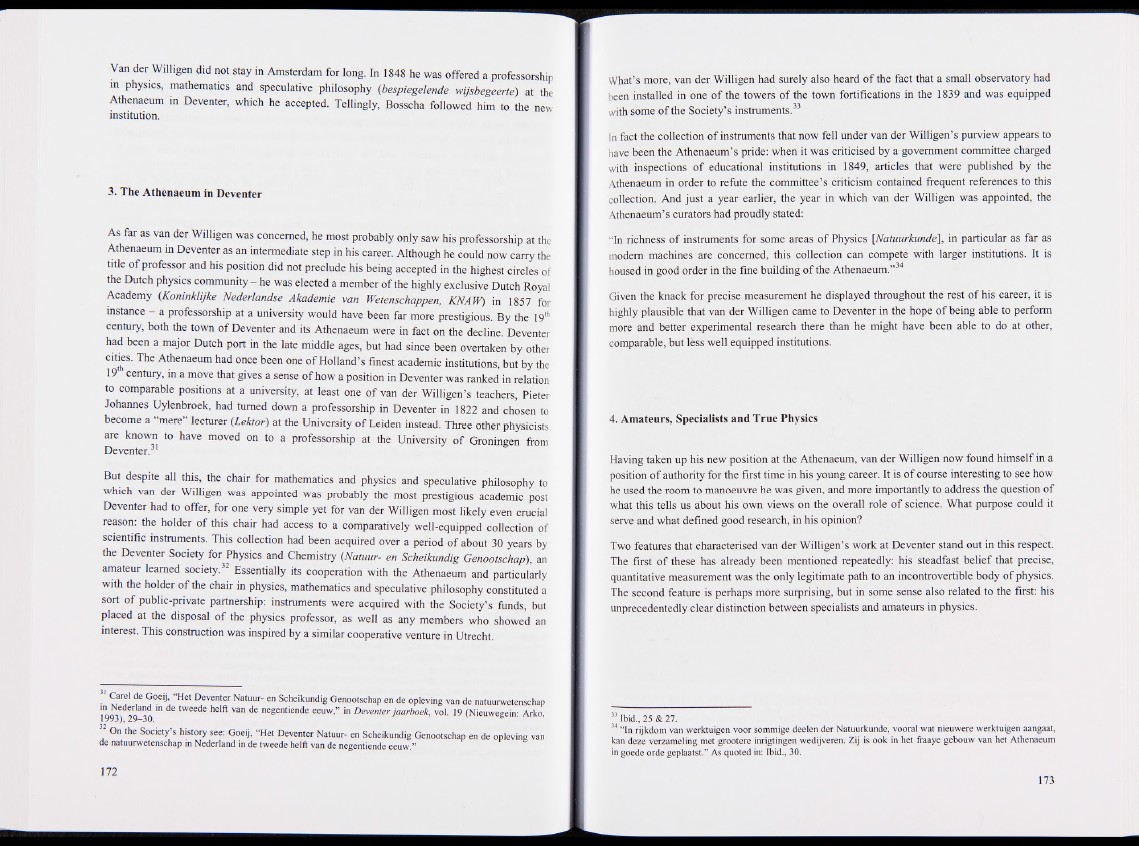
Van der Willigen did not stay in Amsterdam for long. In 1848 he was offered a professorship
in physics, mathematics and speculative philosophy (,bespiegelende wijsbegeerte) at the
Athenaeum in Deventer, which he accepted. Tellingly, Bosscha followed him to the new
institution.
3. The Athenaeum in Deventer
As far as van der Willigen was concerned, he most probably only saw his professorship at the
Athenaeum in Deventer as an intermediate step in his career. Although he could now carry the
title of professor and his position did not preclude his being accepted in the highest circles of
the Dutch physics community - he was elected a member of the highly exclusive Dutch Royal
Academy (Koninklijke Nederlandse Akademie van Wetenschappen, KNAW) in 1857 for
instances a professorship at a university would have been far more prestigious. By the 19th
century, both the town of Deventer and its Athenaeum were in fact on the decline. Deventer
had been a major Dutch port in the late middle ages, but had since been overtaken by other
cities. The Athenaeum had once been one of Holland’s finest academic institutions, but by the
19 century, in a move that gives a sense of how a position in Deventer was ranked in relation
to comparable positions at a university, at least one of van der Willigen’s teachers, Pieter
Johannes Uylenbroek, had turned down a professorship in Deventer in 1822 and chosen to
become a “mere” lecturer (Lektor) at the University of Leiden instead. Three other physicists
are known to have moved on to a professorship at the University of Groningen from
Deventer.
But despite all this, the chair for mathematics and physics and speculative philosophy to
which van der Willigen was appointed was probably the most prestigious academic post
Deventer had to offer, for one very simple yet for van der Willigen most likely even crucial
reason: the holder of this chair had access to a comparatively well-equipped collection of
scientific instruments. This collection had been acquired over a period of about 30 years by
the Deventer Society for Physics and Chemistry (Natuur- en Scheikundig Genootschap), an
amateur learned society.32 Essentially its cooperation with the Athenaeum and particularly
with the holder of the chair in physics, mathematics and speculative philosophy constituted a
sort of public-private partnership: instruments were acquired with the Society’s funds, but
placed at the disposal of the physics professor, as well as any members who showed an
interest. This construction was inspired by a similar cooperative venture in Utrecht.
■ P C?°eijj ”Het Deventer Natuur- en Scheikundig Genootschap en de opleving van de natuurwetenschap
fW g m m de tweede helft van de negentiende eeuw,” in Deventer jaarboek, vol. 19 (Nieuwegein: Arko,
On the Society’s history see: Goeij, “Het Deventer Natuur- en Scheikundig Genootschap en de opleving van
de natuurwetenschap in Nederland in de tweede helft van de negentiende eeuw.”
What’s more, van der Willigen had surely also heard of the fact that a small observatory had
been installed in one of the towers of the town fortifications in the 1839 and was equipped
with some of the Society’s instruments.
In fact the collection of instruments that now fell under van der Willigen’s purview appears to
have been the Athenaeum’s pride: when it was criticised by a government committee charged
with inspections of educational institutions in 1849, articles that were published by the
Athenaeum in order to refute the committee’s criticism contained frequent references to this
collection. And just a year earlier, the year in which van der Willigen was appointed, the
Athenaeum’s curators had proudly stated:
“In richness of instruments for some areas of Physics [Natuurkunde\, in particular as far as
modem machines are concerned, this collection can compete with larger institutions. It is
housed in good order in the fine building of the Athenaeum.”34
Given the knack for precise measurement he displayed throughout the rest of his career, it is
highly plausible that van der Willigen came to Deventer in the hope of being able to perform
more and better experimental research there than he might have been able to do at other,
comparable, but lèss well equipped institutions.
4. Amateurs, Specialists and True Physics
Having taken up his new position at the Athenaeum, van der Willigen now found himself in a
position of authority for the first time in his young career. It is of course interesting to see how
he used the room to manoeuvre he was given, and more importantly to address the question of
what this tells us about his own views on the overall role of science. What purpose could it
serve and what defined good research, in his opinion?
Two features that characterised van der Willigen’s work at Deventer stand out in this respect.
The first of these has already heen mentioned repeatedly: his steadfast belief that precise,
quantitative measurement was the only legitimate path to an incontrovertible body of physics.
The second feature is perhaps more surprising, but in some sense also related to the first: his
unprecedentedly clear distinction between specialists and amateurs in physics.
33 Ibid., 25 & 27.
34 “In rijkdom van werktuigen voor sommige deelen der Natuurkunde, vooral wat nieuwere werktuigen aangaat,
kan deze verzameling met grootere inrigtingen wedijveren. Zij is ook in het fraaye gebouw van het Athenaeum
in goede orde geplaatst.” As quoted in: Ibid., 30.